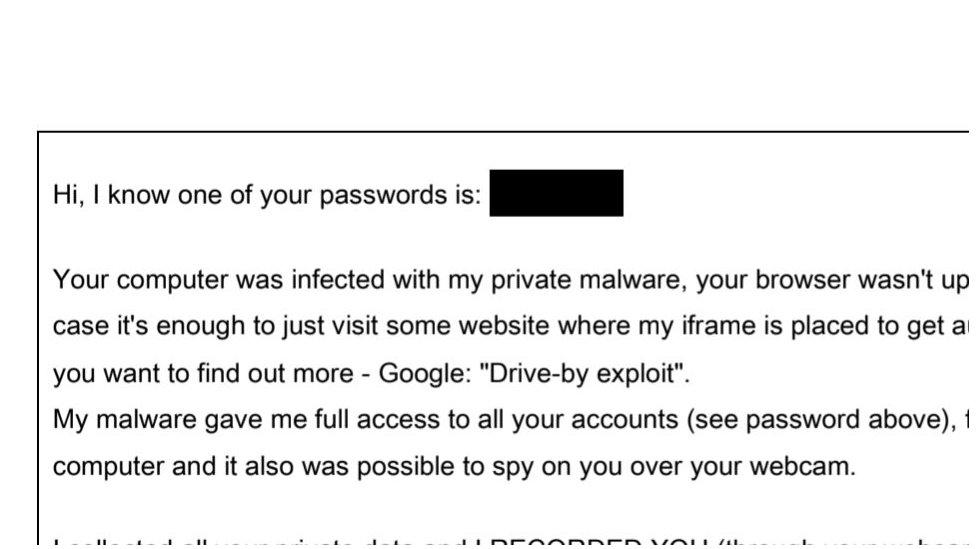'Sextortion botnet spreads 30,000 emails an hourвҖҷ
- Published

A portion of one typical email sent by the botnet
A large-scale вҖңsextortionвҖқ campaign is making use of a network of more than 450,000 hijacked computers to send aggressive emails, researchers have warned.
The emails threaten to release compromising photographs of the recipient unless $800 (ВЈ628) is paid in Bitcoin.
And they contain personal information - such as the recipientвҖҷs password - probably gathered from existing data breaches, to specifically target more than 27 million potential victims at a rate of 30,000 per hour.
While analysis suggests a small fraction of targets have fallen for the ploy, one expert said such botnets still offered a great вҖңreturn on investmentвҖқ for cyber-criminals.
вҖңA botnet can be used for many, many things,вҖқ said Charles Henderson, from IBMвҖҷs X-Force Red security team. вҖңThis was just one task assigned to it.вҖқ
Hard to trace
A botnet is a network of computers taken over by hackers using malicious software typically spread via infected web pages or email attachments.
They can carry out attacks spread across a wide number of machines, making it harder to disrupt and the attackerвҖҷs origins harder to trace.
Security company Check Point said this latest sextortion attack used the Phorpiex botnet, active for more than a decade.
Research head Yaniv Balmas said those whose computers - Windows or Mac - had been hijacked would probably not know.
вҖңAttackers are simply using the victims' computers as vessels,вҖқ he said.
'Save Yourself'
Spreading an email campaign across a botnet in this way would reduce the risk of the emails being flagged as spam - though itвҖҷs not clear how many were able to reach peopleвҖҷs inboxes.
вҖңThe criminals are getting smart enough to use a larger botnet and sending fewer emails per machine,вҖқ said Mr Henderson, who was not involved in Check PointвҖҷs research but has observed the same botnet in operation.
Experts advise using the latest versions of software - particularly web browsers, in this instance - to avoid being susceptible to this kind of attack.
A typical email sent by the botnet - with the subject line: вҖңSave YourselfвҖқ - will say: вҖңMy malware gave me full access to all your accounts (see password above), full control over your computer and it was possible to spy on you over your webcam.вҖқ
The claim is not true but the emails include a genuine password associated with the targetвҖҷs email address.
вҖңThe attacker is saying, вҖҳHey, we hacked your computer, we saw you doing this and that, and this proves it. This is your passwordвҖҷ,вҖқ Mr Balmas said.
'Day jobs'
Check Point monitored one Bitcoin wallet used to collect funds from the scam and found about 11 bitcoin - almost $100,000 - was collected in a five-month period.
вҖңMost people don't fall for sextortion scams,вҖқ Mr Balmas said. вҖңBut itвҖҷs the rule of big numbers. If I'm sending 100,000 sextortion emails, itвҖҷs enough that 100 people fall for the trap. I get my money.вҖқ
He said it was likely the same botnet was being used to carry out other, more lucrative attacks, such as the theft of credit card details.
вҖңItвҖҷs not somebody doing this from his garage,вҖқ Mr Balmas said.
вҖңItвҖҷs a group of individuals doing this for their day jobs. This is their business.вҖқ
Follow Dave Lee
Do you have more information about this or any other technology story? You can reach Dave directly and securely through encrypted messaging app Signal on: +1 (628) 400-7370.
- Published2 October 2019